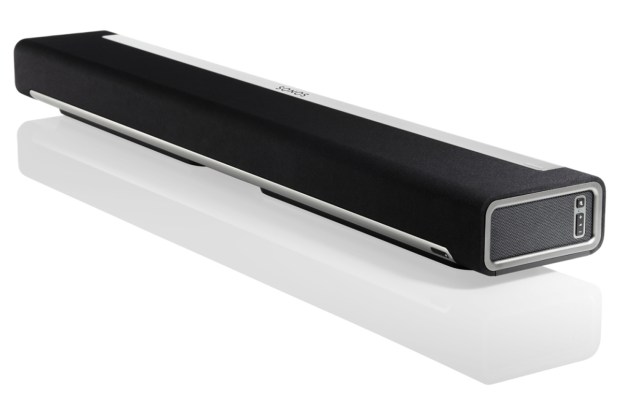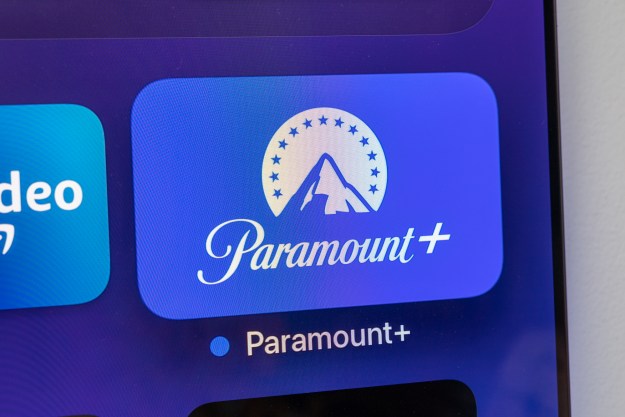
“If you don’t need the extra inputs, and streaming music quality, ease of use, and class-leading design are high priorities, the Sonos Playbar earns a solidly enthusiastic recommendation.”
- Large, expansive sound field effectively wraps sound around you
- Awesome loudness capability, yet low on distortion
- Warm, easy-on-the-ears sound makes long-term listening a breeze
- Best aesthetic design we’ve seen yet for a soundbar
- Pricier than the competition – even pricier with a subwoofer
- Single input woefully limits flexibility
While there are plenty of ways to improve upon the sound coming from your TV’s speakers, sound bars are currently the most popular. Today, nearly every major speaker or TV manufacturer has at least one in its lineup, and the once-novel sound bar category has grown to offer a dizzying array of choices in all manner of sizes and prices.
Wireless speaker-specialist Sonos has recently jumped into the sound bar mix with its all-new Playbar model. Billed as “The sound bar for music lovers,” the Playbar attempts to marry the typically home theater-centric sound bar with Sonos’ music-centric streaming features for a unique variation on the theme. We got our mitts on one of the first available review samples and put the Playbar to the test.
Out of the Box
“Wow!” That’s exactly what came out of our mouths when we unboxed the Playbar for the first time—it definitely looks and feels more luxurious than your typical plasticky sound bar. We were so captivated by its smooth, matte-finished aluminum panels and wrap-around cloth grille, we couldn’t stop running our hands over it. It almost seemed naughty the way we were feeling it up, caressing every finely finished surface.
Together with its contoured edges, mesh-covered end caps, and sleek, modern aesthetic, the Playbar’s many unique design touches certainly makes it one of the best-looking sound bars we’ve seen yet.

At just under 35.5-inches wide, the Playbar isn’t the largest sound bar we’ve tested, nor is it the smallest. Coupled to a height of 5.51-inches and a depth of 3.35-inches, the Playbar has a refreshingly thin form factor, unlike the more typical box shape that’s ubiquitous to most other sound bars. Overall, we liked that the Playbar wasn’t sized nor styled to be some shrinking violet sitting on top of your A/V stand.
Maneuvering the Playbar for setup proves it’s not just some toy wrapped up in fancy packaging, either. With a weight of nearly 12 pounds, the
Working our way around the unit’s body shows
Taking inventory of other items inside the box, we found a Toslink fiber optic cable, an AC power cord, and user manuals nested in a separate accessories box.
Features
Another feature unique to Sonos’ sound bar is its placement-versatile design. The Playbar can be positioned upright and against a wall, or laid flat and on top of an A/V stand. Two rubber bumpers around the mounting inserts on the backside facilitate wall placement without marring the contacting surfaces.
…We were immediately impressed with the smooth, rich, and clear sound…
The Controller app works on both Mac and PC computers along with Droid or iOS tablets or smartphones. Every available music service app comes preloaded with the
Once your network is set up, you can incorporate an unlimited number of other
Since
Like other
For all of its design ingenuity and user-friendliness, the
Setup
Setting up the Playbar was plenty intuitive and straightforward. First, we had to connect the sound bar to our network, either by plugging in the included
Total time from setup to playback readiness took less than 5 minutes …
We then finished setting up our Playbar by downloading and installing Sonos’ Controller app from Apple’s app store to our iPhone. Total time from setup to playback readiness took less than 5 minutes, not including the time it took to get the software and apps installed onto our laptop and mobile device.
Performance
We decided to test the Playbar the way we figured most users would, straight out of the box and without any break-in. Other components used in this review were a Samsung BD-C5500 Blu-ray Player, iPhone 4, Denon DCD-CX3 SACD player, HP Pavilion G6-2320DX laptop, and a Samsung UN40C6300 LED TV.
A quick note about placement: Since we weren’t able to wall mount the Playbar in our room, we initially set it up on our A/V stand so that the speakers and the broadside of the grille were pointing up towards the ceiling. Although
Once we settled in to listen, we were immediately impressed with the smooth, rich, and clear sound pouring out of the Playbar. Running through the usual test movie suspects, we continuously marveled at how it expanded the sound field of every movie we tried. Sound effects from our favorite action scenes, such as the various gun shots, vehicle chases, and explosions during the final battle scene from The Dark Knight Rises, seemed to convincingly wrap around us, immersing us deep into the movie.

What’s more, the Playbar easily filled our larger-than-average listening room with gobs of volume, all the while sounding clean, composed, and virtually distortion free. Never once did the Playbar display any sort of break up or dynamic limitations when we cranked up the Avengers and Quantum of Solace to frighteningly loud levels. In fact, only when we activated the Playbar’s Loudness contour and pushed its volume near its maximum did the bass bottom out. Even then, it was hardly noticeable in light of the auditory mayhem the Playbar was impressively throwing down.
Speaking of bass, we were quite impressed with the Playbar’s low frequency capabilities. While it wasn’t the deepest or the most impactful we’ve ever heard, its quality consistently surprised us. Listening to both upright and electric bass lines from Ramsey Lewis’ Legends of Jazz on Blu-ray, for example, we never felt as if these instruments were being shortchanged in any significant way.
Moreover, moving the Controller app’s bass slider up a couple of notches or activating the loudness control did little to diminish the Playbar’s surprisingly nimble bass reproduction. Those craving more impact can always add extra oomph with Sonos’ excellent Sub, but the Playbar did a fine job of maintaining its accuracy and pitch definition with just a hint of warmth thrown in for good measure.
That bit of warmth extends all the way up to the high frequencies as well, giving the

That same Lewis disc, along with a wide variety of music files ranging from Rachmaninoff to The Roots streaming from our iPhone or our computer,
We should also note that the Playbar’s operational performance was just as good as its sonic performance. Both of Sonos’ PC and iPhone Controller apps worked flawlessly throughout our testing, and we appreciated how easy it was to explore and save internet radio stations to our favorites list for repeated listening. Every control and playback feature was easy to find and understand, and navigating the apps couldn’t have been more intuitive.
The same goes for Sonos’ excellent wireless network. This is the second time we’ve used a
In fact, the only real drawback that sticks in our craw is the Playbar’s single audio input. While we realize the typical

Most owners use their soundbars as the central sound hub for all of the A/V equipment in the room, which is what we did during our testing. But when we wanted to hear better sound from some computer-only, Hulu-sourced TV shows, for example, we had to move our laptop from the opposite end of the room much closer to the TV, hook it up with an HDMI cable, and then switch the TV to the appropriate input.
Including a simple analog input would’ve quickly and easily solved this problem. We could’ve placed a wireless audio transmitter, such as the Audio Engine AW3 or the Aperion Audio Zona Home Audio Link, between the Playbar and our laptop, thereby eliminating any need to get our lazy butt off the couch. Many lower-priced soundbars have at least one analog input on board; we think
Conclusion
The
There is, of course, the matter of the Playbar’s woefully limited input options. Not having any analog inputs and only a single digital input could be a major oversight for those looking to use their legacy sources with the Playbar. Since
There’s also the matter of price. Sonos’ trademark feature has always been its outstanding wireless mesh network, and a large part of what you’re paying for with the Playbar is that very feature. If this isn’t something you need, there are a few sound bar packages that offer even better sound (if not necessarily more features) for the same money, such as the subwoofer-armed Klipsch SB-3 package we recently reviewed. Adding the
Still, if you don’t need the extra inputs, and streaming music quality, ease of use, and class-leading design are high priorities, the
Highs:
- Large, expansive sound field effectively wraps sound around you
- Awesome loudness capability, yet low on distortion
- Warm, easy-on-the-ears sound makes long-term listening a breeze
- Best aesthetic design we’ve seen yet for a soundbar
Lows:
- Pricier than the competition – even pricier with a subwoofer
- Single input woefully limits flexibility
Editors' Recommendations
- Best 75-inch TV deals: Get a big screen from $470
- Best 70-inch TV deals: Get a big screen for sports for $420
- Best 65-inch TV deals: Get a 65-inch 4K TV for under $400
- Best Sonos deals: Save $176 on speakers, soundbars and more
- Best Bluetooth speaker deals: Save on Bose, Sonos, JBL, and more






